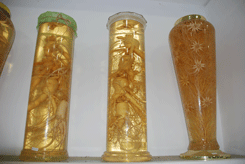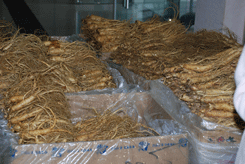Hansik
Ginseng
It is a medicinal herb that has long been used in maintaining physical vitality throughout the far eastern countries including Korea and China. Carl Amon Meyer, Russian botanist named Korean ginseng Panax ginseng in 1843. The genus name Panax means 'cure all' in Greek. The first record of prescription of ginseng as a medicinal herb appears in the 6th century. Generally, Korean ginseng is harvested 4~6 years after the sowing. The fresh harvested ginseng root is called Susam, which contains 75% of water. Dried ginseng is called white ginseng. There are three types of white ginseng, Straight, Curved, and Half-curved. Red ginseng is made by steaming and drying carefully selected six-year-old roots without peeling off the skin. The color turns into light reddish brown or deep maroon. Quality of red ginseng is determined by the characteristics such as the size of rhizome head, balance of main and lateral roots, skin color, and internal tissue morphology. The grades are Heaven, Earth, and Good, etc. The major component of Korean ginseng is carbohydrates such as starch, polysaccharides and cellulose. However, it contains various compounds unique to ginseng such as ginsenosides, polyacetylenses, antioxidative aromatic compounds, gomisins which protect liver, and acidic peptides which behave similar to insulin. Ginseng saponins, known as major effective compound in Korean ginseng is called ginsenosides. Various pharmacological activities of ginseng saponins are as follow.
1. Ginseng saponin Oleanolic acid
Ginsenoside Ro
Anti-inflamation, Detoxificaiton, Anti-trombin, Inhibition of blood coagulation, Anti-hepatitis, Activation of macro-phage.
2. Panaxadiol
Ginsenodie Ra 1-3
Ginsenodie Rb 1
CNS suppression, Sleep including, Analgesic, Ataractic, Antifebric, Promotion of serum protein synthesis (insulin like function), Promoion of cholesterol biosynthesis, Plasmin activation, Promotion of RNA synthesis, Promotion of adrenal cortex hormone secretion.
Geinsenoside Rb2
CNS suppression, promotion of synthesis of DNA and RNA, Plasmin activation, Promotion of adrenocorticotrophic hormone secretion, Anti-diabetic.
Ginsenoside Rb 3
Ginsenoside Rc
CNS Suppression, RNA synthesis suppression, Promotion of serum protein synthesis, Plasmin activation, Promotion of adrenocorticotrophic hormone secretion.
Ginsenoside Rd
Promotion of adrenocortical hormone secretion
Ginsenoside Re
CNS suppression, Promotion of synthesis of DNA and RNA, Plasmin activation, Promotion of adrenocorticotrophic hormone secretion.
Ginsenoside Rf
Alleviation of pain related to brain nerve cells.
Ginsenoside Rg 1
Excitation of CNS, Anti-fatigue, Helps recovery from fatigue, Improvement of memory and learning capability, Promotion of synthesis of DNA and RNA.
Ginsenoside Rg 2
Anti-platelet, Plasmin activation
3. Red ginseng saponin
Panaxadiol
Ginsenoside Rh 2
Suppression of cancer cell growth, Anti-tumor
Ginsenoside Rg 3
Suppression of cancer cell spread
Panaxatriol
Ginsenoside Rh 1
Ginsenoside Rb 4
Ginseng is said to invigorate the body, strengthen the lung and spleen and relieve the heart. The effect of Korean ginseng described in Pen Ts'ao Kang Mu are interpreted with a view of modern medicine and summarized as follows.
1. Quickly restores men and women from weakness, and aids the function of internal organs.
2. With nerve tonic effect, relaxes palpitation and uneasiness.
3. Prevents viral disease and influenza by increasing the resistance.
4. Makes eye keen and enhances brain activity.
5. Has a notable effect on the subjective symptoms of diabetes such as thirst, overeating, and frequent urination.
6. Halts severe vomiting.
7. Strengthens the stomach function, cures the acid dyspepsia and enhances digestive action.
8. Good for vomiting and habitual diarrhea caused by chronic gastroenteritis.
9. Helps reduce the gas in the stomach and the large intestine.
10. Good for internal diseases accompanied by physical weakness due to overwork or improper nourishing.
11. Can be used in case of paralysis or malfunction of hands and legs due to stroke or cerebral apoplexy. And good for chill in the stomach as well as indigestion by suffering from heat.
12. If one takes ginseng regularly for a long period of time, it invigorates body and prolongs life.
13. Use it when one feels oppressed in the chest and has difficulty in breathing due to indigestion or lack of physical vitality.
14. It destroys, terminates, and restores the tumor tissues including cancer.
15. promotes secretion from gall bladder and bronchus.
16. Good for indigestion from cold accompanied by fever.
17. Good for poisoning by misuse of mineral medicine.
18. Strengthens the lung function when breathing capacity decreases and irregular breathing occurs.
19. When in short of humor due to exhaustion, it promotes secretion of the body fluids.
20. Use it for all kinds of gynecological diseases during pregnancy or after birth. It also vitalizes stamina, helps supplementing blood, and stops hemoptysis, hematuria, and bleeding in the uterus, colon, and stomach.
21. Controls fever caused by overworking of the heart, the lung, and the digestive system due to physical weakness or excessive labor.
22. Good for bad diarrhea and colitis.
23. Good for headache and dizziness.
24. Stop sweating from the loss of vitality as well as consumptive fever.
25. Can be used for frequent urination or urination difficulty.
26. As a cardiac stimulant, it promotes metabolism or aids blood circulation when used for neuralgia or paralysis in the limbs.
Ginseng products (both red and white ginseng)
Ginseng root, powder, ginseng Chitosan, capsule, extract, powder capsule, ginseng slice, wine, liquor, drinks, cake, candy, jam, tea, body cleanser









